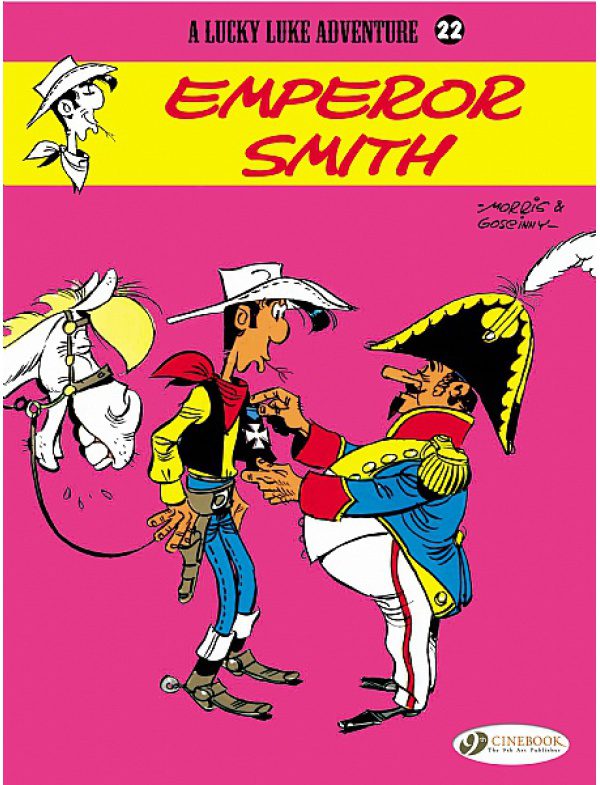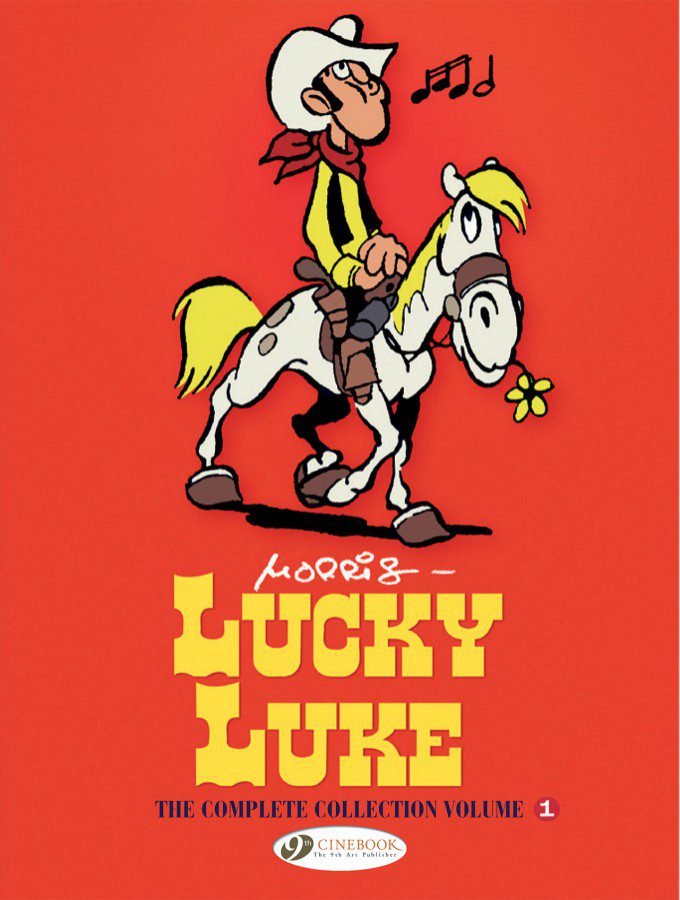
Lucky Luke characters on a fresco in the Parc metro station, Charleroi, Belgium.
When a series—whether of movies, television episodes, books, or comics—reaches a certain number of entries, many come to view that series with suspicion. They often have good reason. Many stories, after running their natural course, are artificially stretched and extended merely for profit. The results are, all too often, bastardized and money-grubbing works with little artistic integrity.
It is not hard to produce examples. Star Wars, for instance, began as a passion project undertaken by the young filmmaker George Lucas, inspired by great tales of yore and deeply informed by the work of Joseph Campbell. It has stoked the wonder of several generations and inspired artists of many kinds. Viewers became attached to the characters, and the dialogue—though at times a bit hokey—has embedded itself in American, and arguably even world, culture. While the prequel trilogy from the early 2000s is not so universally-beloved, for many it renewed the joy of the original series. In 2012, Disney acquired Star Wars. It proceeded to produce a trilogy of films that, in addition to being generally disliked by audiences, showed clear contempt for the source material and arguably even for the millennia of stories that inspired it. These three films are detested by virtually all who love Lucas’ original works, and many of us try to pretend they just never happened.

Despite the many examples of uninteresting sequels, prequels, and spin-offs, there is the occasional series that remains true to its original spirit many decades after its initial inception. For some reason, there are some stories and characters that weather the changing times—and even changing authors and artists! One such series, in my judgment, is Lucky Luke, the comic, or more properly bande dessinée, starring the eponymous cowboy. First published in 1946, consisting today of 82 books, and now released (with distinct numbering) in English by Cinebook, this comic has remained true to its core while taking its protagonist on virtually every imaginable adventure.
Created by the cartoonist Morris in the 1940s, Lucky Luke entertains readers with the exploits of its hero as he adventures throughout the American Wild West of the nineteenth century. The hero is a charming cowboy with a quick wit and an even quicker draw—he is, as the comic puts it, “the man who shoots faster than his own shadow.” But he is not notable only for his skill with a gun; he has a heart of gold and will always stick up for the little guy. This, naturally, means that he is kept quite busy in the Wild West, where there are many villains and criminals looking to impose their wicked wills on the innocent.
The series’ art, provided by Morris for more than fifty years and by Hervé “Achdé” Darmenton for the last two decades, fits the storytelling like a glove. After the first few albums in which the characters were a bit rubbery, Morris settled on a style that is somehow simultaneously cartoonishly elongated and realistic. This distinctive look complements the comic’s balance between comedic moments and engaging plots.

This balancing of comedy with storytelling is central to the comic’s perennial appeal. Take, for instance, my favorite Lucky Luke album, The Singing Wire (Le Fil qui chante in the original French), which bases its plot around the construction of the first transcontinental telegraph. The story begins with a masterful two-pages showing what communication was like in America before the telegraph. The two pages have a few jokes in them, but at the same time they immediately encourage the reader’s investment in the story: the work that the men in this story aim to accomplish has an existentially meaningful purpose. After the stage is set, Lucky Luke appears on the page. He is tasked by the president, Abraham Lincoln, with protecting the group of men constructing the telegraph, and he accepts. The rest of the album tells of the travels, travails, and triumphs of Lucky Luke and the construction team. Throughout the story, there are constant gags—slapstick and puns, character-based jokes and mutual misunderstandings. These gags keep readers entertained, but the plot keeps readers hooked.

Also crucial to the comics’ success are the various ways Morris and the writers make use of the Wild West setting. There are a number of albums like The Singing Wire that take firm historical fact as their basis and then run with it. Then there are stories that approach a seemingly mundane Wild West story and give it the Lucky Luke treatment, like Doc Doxley’s Elixir, which focuses on Luke taking down a crooked traveling salesman. A number of albums sit somewhere in between, like Emperor Smith (a more imaginative version of the real-life Emperor Norton) or Bride of Lucky Luke, which takes a somewhat realistic premise (transporting mail-order brides) and makes it larger-than-life. Whichever story type a given album exemplifies, readers are in for a treat.
While the nature of the stories can vary radically, there are also certain comforting similarities. I don’t mean that the stories are formulaic, only that you know what you’re getting when you pick up a Lucky Luke album. You know that there will be some Wild-West-style action. You know there will be silly jokes. And you know that (with the exception of the first few stories), the album will end with Lucky Luke atop his talking horse Jolly Jumper riding into the sunset singing “I’m a poor, lonesome cowboy/and a long way from home…”
With all this going for the comic, it is not hard to see why Lucky Luke is one of the most popular and long-running bande dessinée ever. But let’s return to the considerations with which I opened this article: there are many long-running series that begin strong but in time lose their charm. What differentiates Lucky Luke? To begin to answer this question, it is useful to know a bit about the history of the series.
Maurice De Bevere (Morris), Lucky Luke’s originator, was born in Belgium in 1923. A great doodler throughout boyhood, Morris discovered Tintin comics at the age of ten. This ignited a love of comics that would continue until his death in 2001. He got his professional start working for a small animation studio. While there, he befriended three co-workers who would also later go on to become famous bande dessinée writers and artists: Franquin (of Spirou and Fantasio), Peyo (of The Smurfs and Johan and Peewit), and Eddy Paape (of Luc Orient). The animation studio soon folded, and all four were forced to look for work elsewhere, though their friendships (and mutual artistic influence) continued.

Morris was hired by Le Journal de Spirou, and in 1946 the magazine began publishing his Lucky Luke comics. While Morris clearly stands in the Franco-Belgian tradition of bande dessinée, his genius cannot be properly understood without seeing how he integrated elements picked up from American cartoonists into his comics. He was profoundly influenced by Disney cartoons and comics, including Floyd Gottfredson’s immortal Mickey Mouse comics, as well as Harold Knerr’s Katenjammer Kids, George Baker’s Sad Sack, and E.C. Segar’s Popeye. The influence of Disney and Segar is particularly pronounced in the early albums, but it is present in every Lucky Luke story Morris illustrated.
The first three albums—collected together in English in Lucky Luke: The Complete Collection Volume 1 along with an extensive 50 page introduction—showed that Morris was still experimenting with and figuring out the exact nature of the comic he wanted to write. At the same time, the early comics are really entertaining, and they boast some of the best physical comedy of any comic I have ever had the pleasure to read.
In 1955, Lucky Luke truly came into its own when René Goscinny (later of Asterix fame) began writing the comic with Morris illustrating. The collaborations between Morris and Goscinny had all the same excellent aspects of the earliest stories, but the plots got tighter, the humor got more consistent, and the art continued to develop. (For anyone who has never read Lucky Luke before, these Goscinny/Morris volumes are the perfect place to start—check out The Singing Wire or The Bounty Hunter.)Goscinny penned stories for the series until his death in 1977. Morris continued to draw Lucky Luke with a few others writing scripts until his own passing in 2001.

After Morris died, Achdé took over responsibilities for the art. Achdé has very intentionally maintained Morris’ characteristic style, but he has his own distinctive strengths (I particularly appreciate his background details like building design and landscapes—on full display in A Cowboy in Paris). For the first decade, Achdé worked with several different writers. Julien “Jul” Berjeaut has written the last four volumes, and this collaboration has thus far borne the fruit of inventive stories and great comedy.

In addition to 82(!) albums of Lucky Luke, there have been a number of officially-licensed stories that are not part of the main series. There is the ongoing series Kid Lucky, as well as albums by Guillaume Bouzard, Mawil, and Ralf König. But perhaps the best-known are the two volumes by Matthieu Bonhomme, The Man Who Shot Lucky Luke and Lucky Luke: Wanted. These stories have their own distinctive flavor, being more dramatic and character-driven than the original comics. However, Bonhomme’s reimagining does not feel untrue to the main series. It clearly springs from a real love for the original comics by Morris and desire to make stories inspired by the works that came before.
This, fundamentally, seems to be what makes Lucky Luke so enduring: the fact that the people who have picked up their pens after Morris and Goscinny have genuinely appreciated the past decades of comics that have preceded their own work. The stories do not feel either like cynical cash-grabs or like deconstructivist take-downs of the original stories—as, for instance, the most recent Star Wars trilogy. Yes, there are things that change with time—Lucky Luke smoked for many years but has since shifted over to chewing straw, and some of the jokes in earlier albums would be unlikely to appear in a contemporary one—but the series has stayed true to itself.
From the beginning, Lucky Luke has brought readers from around the world to the Wild West and presented them with a funny, charming, honorable cowboy. In a time when the world is so skeptical of heroes who do what is right no matter what, perhaps Luke has been able to keep his soul in part because he does not take himself too seriously. The comic’s balance of the serious and the hilarious has made it easier for the contemporary writers to respect what has come before.
In addition, there is something any series needs to endure and grow over time, something this series has in its name: luck. If Disney had been staffed by more gifted people who better appreciated Star Wars and the tradition in which it stands, perhaps we would be enjoying a renaissance of Star Wars on the big screen. But that franchise had the bad luck of being sold at a time when there was very little magic in the House of Mouse.
Thankfully, Luke has had the great luck to be written and illustrated by people who love and believe in him, people who recognize that there is still an audience for stories of cowboys and the Wild West. There is still an audience for silly, goofy comedy about people who try to do the right thing while not taking themselves too seriously. As it turns out, we can all use a little more time with a poor lonesome cowboy a long way from home.
